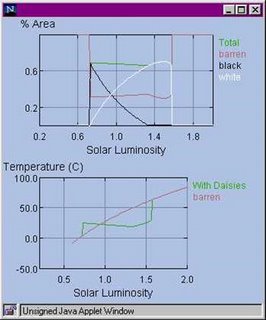
Lovelock (1992) continued.
"…The object of the model is to show that the simple growth and competition for space between the two daisy species can keep the temperature of Daisyworld constant and comfortable over a wide range of radiant heat output from the star. [The graphs] show how Daisyworld evolves. At the start of the first season, after the planetary temperature reaches 5 degrees Celsius, daisy seeds begin to germinate. After their emergence, dark coloured daisies, which absorb more heat, are at an advantage, since in the feeble sunlight they alone would be warm enough to grow. The few seeds produced at the end of the season would nearly all be of dark daisies. At the start of the next season, dark daisies would dominate and soon begin to spread, warming themselves and the area they occupied. Then, with explosive positive feedback, temperature and daisy growth would rise until a large proportion of the planetary surface was covered by dark daisies. Their growth, though, would not continue indefinitely for two reasons: first, too high a temperature suppresses growth, and second, on a warm planet there would be competition for space from light coloured, heat reflecting daisies. As the star warmed, the planetary ecosystem would change from one dominated by dark daisies to one dominated by light coloured daisies. It is the nature of stars to grow hotter as they age, and eventually the ecosystem of daisies would collapse when a total planetary surface cover of light daisies was insufficient to keep the planet cool."
"The model is quite general, and works as well if the growth of the organisms alters the cloud cover or the abundance of greenhouse gases. Indeed, models of the early Earth where bacterial ecosystems regulate climate and gas composition work just as well as does Daisyworld. The geophysiological models are robust in a mathematical sense, use equations in their natural nonlinear form, and are almost entirely insensitive to the initial conditions. Daisyworld is in fact the mathematical basis of Gaia theory... "
"…Whether right or wrong, Gaia provides a very different, a top-down view, of our planet, in a world where science grows ever more conservative and dogmatic. I think we need to make room for the kind of errors that leads us closer to the truth. As the economist Vilfredo Pareto said, "Give me a fruitful error any time, full of seeds, bursting with its own corrections." (Lovelock, 1992)
Return to Daisy World
Return to Nature, Art & Language Homepage
Gaia Part 3
To hear James Lovelock speak on climate change click on the link below :
'We're dammed if you do and dammed if we don't.'